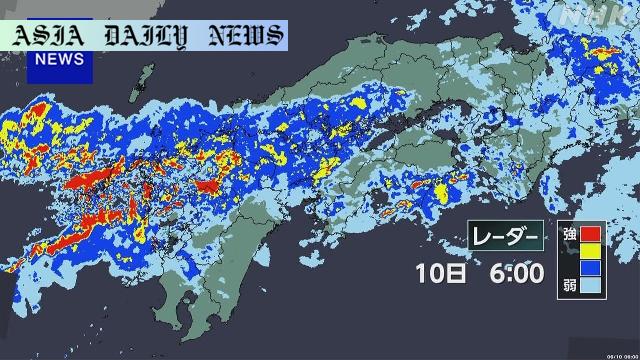Kyushu Downpours – Japan’s weather authorities warn torrential downpours may continue through Wednesday in northern Kyushu, causing potential risks of disasters.
Kyushu is expected to experience torrential downpours caused by heavy rainclouds.
Rainfall up to 180mm may cause flooding, landslides, and swollen rivers.
The Meteorological Agency urges caution as risks of disasters may rise rapidly.
Weather conditions are unstable due to warm, moist air forming near the rain front.

Heavy Downpours Threaten Northern Kyushu
The northern Kyushu region of southwestern Japan has been placed on high alert by the country’s weather authorities as torrential downpours are expected to continue through Wednesday. Atmospheric instability caused by warm, moist air interacting with a seasonal rain front has resulted in the formation of heavy rainclouds over the region. This weather pattern has already brought record-setting rainfall to southern Kyushu on Monday, with Kagoshima Prefecture’s city of Ibusuki experiencing a staggering 345.5 millimeters of rain—the highest recorded since weather tracking began in 1976.
Potential for Disaster in Affected Regions
Weather models predict that the rain front may remain stationary near Kyushu through Wednesday, exacerbating the risk of disasters. Between Tuesday and Wednesday morning, northern Kyushu could see up to 180 millimeters of rain, while the southern part of the island is expected to receive up to 120 millimeters. Nearby regions such as Kinki and Chugoku are also forecasting significant rainfall during this period. Heavy rain and potential disaster risks—such as landslides, floods in low-lying areas, swollen rivers, lightning strikes, and even tornadoes—are expected to escalate quickly in affected areas.
Urgent Call for Caution
The Meteorological Agency has called on residents and authorities to exercise heightened caution as the unstable atmospheric conditions could lead to rapidly deteriorating weather. Individuals in risk-prone areas are advised to monitor weather updates, prepare for potential evacuations, and have emergency supplies on hand. Additionally, residents in prefectures like Fukuoka, Saga, Nagasaki, Oita, and Kumamoto should pay special attention to warnings regarding heavy raincloud bands that might form over these areas through Tuesday evening.
Impacts and Preparation Plans
The impacts of this weather event could be widespread and severe. Low-lying areas and riverbanks are highly susceptible to flooding, and the excessive rainfall could loosen soil, increasing the chance of landslides. In urban areas, the accumulation of rainwater on roads could disrupt transportation, and the gusty winds and lightning strikes might cause power outages or hinder outdoor activities. Local governments and disaster preparedness teams are on standby to assist if the situation worsens, while residents are advised to avoid unnecessary travel and stay informed through local updates.
Conclusion
This weather event highlights the importance of preparedness and vigilance during severe weather conditions. Torrential rains coupled with strong winds and unstable atmospheric conditions can escalate into dangerous situations within a short timeframe. By staying updated through weather alerts and taking necessary precautions, individuals can mitigate risks and ensure their safety. As the rain front lingers near Kyushu, Japan’s efforts in disaster readiness will be put to the test in the coming days.



Commentary
The Unpredictable Nature of Weather Events in Kyushu
Weather events like the one currently gripping northern Kyushu serve as a stark reminder of the unpredictability of nature and its capacity to disrupt normal life. These torrential downpours in Japan not only highlight the sheer power of weather systems but also underscore the importance of preparation and adaptation. With rainfall reaching record-breaking levels in places like Kagoshima Prefecture, it is evident that our environmental systems are experiencing changes that challenge historical patterns and averages.
Understanding the Human Impact
While meteorological updates focus heavily on statistical data—such as millimeters of rain or risk levels—it is crucial to consider the real human impact of these weather events. Families living in flood-prone areas, workers navigating treacherous roads, and emergency responders working tirelessly to ensure public safety are crucial facets that highlight the broader societal implications of heavy rains. Preparing for floods, landslides, and even power outages requires resources and planning, but not every household or community is equipped in the same way, leaving some especially vulnerable to nature’s fury.
Planning Ahead and Investing in Resiliency
In light of this event, it is essential to advocate for stronger disaster preparedness initiatives at both the local and national levels. Infrastructure improvements, early-warning systems, and public education campaigns can go a long way in minimizing the damages caused by such events. Additionally, community-driven efforts—such as neighborhood emergency plans—can be instrumental in mitigating risks for vulnerable populations. Investing in resilience not only saves lives but also reduces long-term economic losses associated with natural disasters.
Conclusion
As Kyushu deals with yet another meteorological challenge, the event should not only prompt immediate responses but also serve as a catalyst for longer-term changes. Governments, local bodies, and citizens must work together to address the root causes and enhance preparedness for the challenges that lie ahead. By taking a proactive stance toward disaster management, we can ensure that communities emerge stronger and more resilient in the face of nature’s uncertainties.